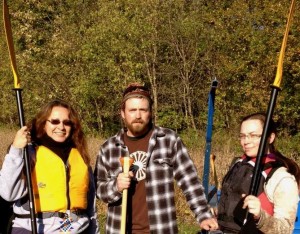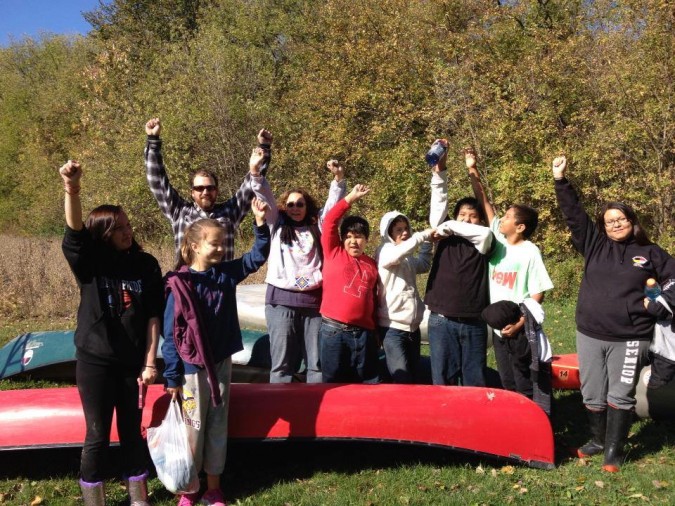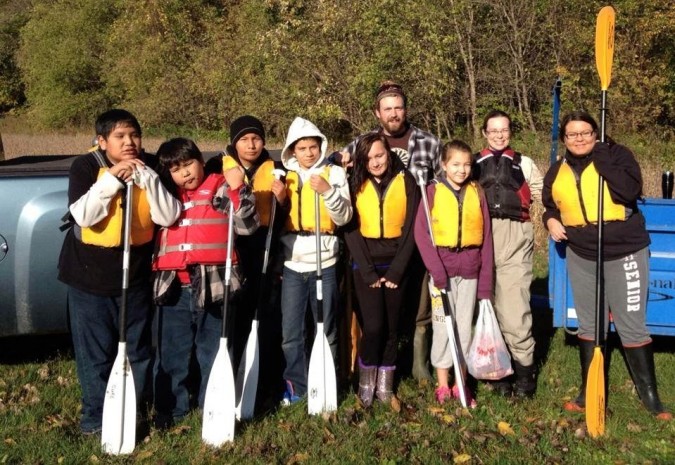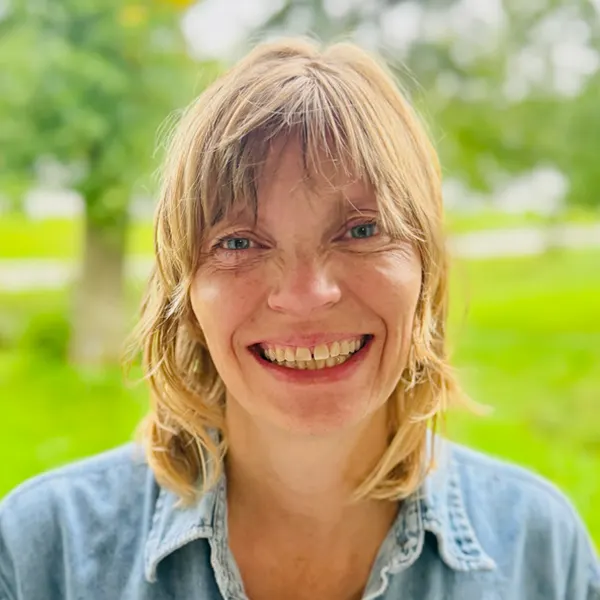By Megan Ulrich, CURE Board Member and USC Water Quality Specialist
On October 16th, six high-school-aged youth and four adults enjoyed a beautiful autumn day, while canoeing and kayaking on the Minnesota River. Several of the participants were in a kayak or canoe for the first time, and many on the river for the first time. We started off by learning safety rules, how to paddle, and how to work together in a canoe or kayak. We launched off the sandbar at the confluence of Wakpa (walk-PA) Mnisota (mnee-SO-ta) (Minnesota River) and Wakpadan (walk-PA-dahn) Chanshasha (chahn-SHA-sha) (Hazel Creek). Wakpa is Dakota for ‘river’, while wakpadan translates as ‘little river’ or ‘creek’. Chanshasha is a type of shrub with red bark that is used in spiritual practice. You may know it as red osier dogwood, or red willow. These shrubs may still be found in our region within the riparian zones (banks) of the creek; although, not in the abundance they once were.
 The river was calm and flowing slowly and the water level was lower than average, but higher than last year at this time. We saw fish jumping and a pileated woodpecker flew overhead. Autumn leaves drifted from the trees and floated atop the water as the sun shone brilliantly. I had a great time canoeing with a 10th grader who asked very good questions about why the water was such a dark green-brown, and if people could make the water better. As we canoed, we talked of the mussels whose empty shells dotted the banks. We looked at the eroding soils on either side of the river, and the vast number of trees falling in from the undercutting of banks. Despite its problems, the Minnesota River Valley is a beautiful, powerful, and special place. When we are outside and not distracted, we get a chance to reconnect with each other and the place around us. Learning is subtle and
The river was calm and flowing slowly and the water level was lower than average, but higher than last year at this time. We saw fish jumping and a pileated woodpecker flew overhead. Autumn leaves drifted from the trees and floated atop the water as the sun shone brilliantly. I had a great time canoeing with a 10th grader who asked very good questions about why the water was such a dark green-brown, and if people could make the water better. As we canoed, we talked of the mussels whose empty shells dotted the banks. We looked at the eroding soils on either side of the river, and the vast number of trees falling in from the undercutting of banks. Despite its problems, the Minnesota River Valley is a beautiful, powerful, and special place. When we are outside and not distracted, we get a chance to reconnect with each other and the place around us. Learning is subtle and  natural in the act of being and doing. This is the power of experiential outdoor environmental education. The entire group was all smiles as is evident in the photos taken by Dawn Chase, Youth Specialist for the Upper Sioux Community. Sophia Blue, Youth Assistant/Recreation Coordinator, and Scott Wold, Environmental Director, were also engaged in creating a fun and safe outing. Thank you to CURE (special thanks to Peg) and to all who made our outing possible. Pidamayaye! (pee-DAH-ma-ya-yay) ~ Thank you, you have made my heart glad!
natural in the act of being and doing. This is the power of experiential outdoor environmental education. The entire group was all smiles as is evident in the photos taken by Dawn Chase, Youth Specialist for the Upper Sioux Community. Sophia Blue, Youth Assistant/Recreation Coordinator, and Scott Wold, Environmental Director, were also engaged in creating a fun and safe outing. Thank you to CURE (special thanks to Peg) and to all who made our outing possible. Pidamayaye! (pee-DAH-ma-ya-yay) ~ Thank you, you have made my heart glad!
The importance of Dakota language in ecological restoration
Dakota language was not a written language, in the alphabetical sense, until after the arrival of Europeans in present-day Minnesota. Therefore, you will see variant spellings of Dakota words when using the English alphabet. Missionaries in the 19th century began recording the Dakota language, and even created a Dakota alphabet with letters with diacritical markings for sounds not found in the English language (as such, the pronunciations in parentheses are an approximation, only). For example, Pezihutazizi (peh-zhee-HU-ta-zee-zee) has been written alternately as; Pejihutazizi, Pajutazee, Pezhutazizi, and Pezuta Zizi to name a few variants. In 2008, the Upper Sioux Community Board of Trustees voted to use the spelling Pezihutazizi. This transition from an oral language to a written language can sometimes create confusion, since the European missionaries used their own language and worldview to create an alphabet for a strictly oral language. Thus, the languages do not translate literally from one to the other. I believe the missionaries were also trying to assimilate the Dakota by forming literacy in both the ‘new’ written Dakota language and eventually the English language. The purpose of this was to translate the Christian Bible into Dakota and convert Dakota people, with their own cultural, traditional, and spiritual ways of life, to Christianity.
Mnisota has been translated as “water which reflects the color of the sky”, “cloudy, but not turbid, water”, or more precisely, “water with clouds above it”. If you have had the opportunity to see the Minnesota River valley on a given morning, you will have a distinct perception of clouds above the water as the valley will often be filled with mist caused by the temperature difference between the water and the air above it. This is a lovely way to teach youth about the visible water cycle processes of evaporation and condensation. This also gives us an idea of how well the Dakota people paid attention to and knew their surroundings, naming places for their own natural qualities, as opposed to naming something after a human to assert one’s dominion over the place.
Dakota is a powerfully descriptive language that clearly describes the purpose and natural traits of things rather than just the appearance of things. Many of our current place names in the U.S. are still the indigenous names or some Anglicized variant, which will tell you more about the place if you understand the meaning. According to Wikipedia, “there are approximately 296 spoken (or formerly spoken) indigenous languages north of Mexico”.
Language is the backbone of a culture
Our spoken language(s) form a lens for us to understand and interpret the world around us. This lens is called our worldview. When we try to understand something from another’s worldview, we enrich our lives with depth. It is like the difference between looking at a drawing of a box on paper, and then looking at an actual 3-dimensional box.
Unfortunately, due to the practices of genocide, colonization, and assimilation there are currently only a handful of fluent, native speakers of the Dakota language dialects of Minnesota. But, there is hope. Within the four Federally Recognized Dakota Communities bounded by the State of MN, there are many individuals working tirelessly, without recognition, and with few resources to teach and learn the Dakota language. Carolynn Schommer, an Upper Sioux Community Elder teaches Dakota at the Yellow Medicine East High School, as well as an intergenerational evening class within the Community. Her daughter, Dawn, also teaches language with the evening class and within her day-to-day youth programming throughout the year. Community youth and other adults also assist with the evening community classes. Dakota Wicohan (wee-CHO-hahn) is a regional non-profit located in Morton, MN which was formed in 2002 in order to preserve Dakota as a living language.
I believe in learning our common human history. To do that, we must look with as many perspectives as possible in order to see the whole picture. Dakota language and culture have given me concepts, words, understanding, and the eyes to see more truthfully what our historical life has been, what it is, and what it might be. We are interdependent and interconnected within this Earth ecosystem, a part of the environment and not separate from it. We must be honest about our modern lifestyles and assess the ways in which it is helping and harming All of Our Relatives with effects reaching far into the future. Many of us are living in a disconnected dream. We don’t understand ecology; the very systems and interactions which allow for life on earth. We don’t know where our water comes from, how it has become polluted, or how to stop polluting. We don’t have a clear understanding of how our actions will affect everything else. We don’t even spend much time outside. We are living in an illusion of modern life which entertains, but does not fulfill and is not sustainable. We may see these things, but believe they are someone else’s responsibility, or we are overwhelmed at the thought of facing the issues we have inherited and continue to create.
How can we have the eyes to see, the heart to understand, and the will to change our present behaviors in order to benefit future generations and to protect All of Our Relations; the animals, plants, soil, rocks, water and air from further damage?
I am asking you to take your loved ones by the hand and get outside. Spend time in stillness and quiet in the powerful beauty that surrounds you. Ask questions. Empower yourself to become a leader in coming back to life.
Mitakuye (me-TALK-kuh-yay) Owasin (oh-WA-see) ~ All My Relations




